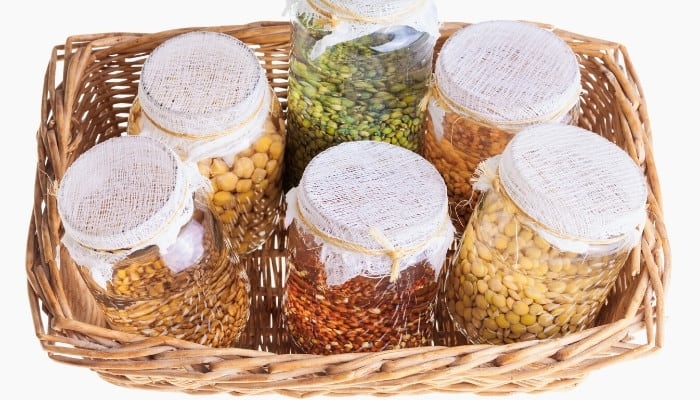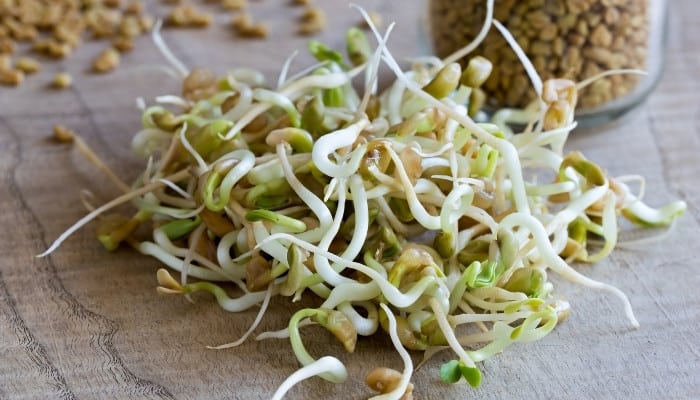It is truly fulfilling to be able to cultivate and consume your own sprouting seeds.
Aside from the obvious nutritional benefits, growing your own sprouting seeds opens the door to more variety than offered by the local supermarket.
In addition, the fact that they are super easy to grow makes them a popular choice among green-thumbed health fanatics around the world.
But are sprouting seeds as beneficial and easy to grow as regular seeds? More importantly, are they the same thing?
Are sprouting seeds the same as regular seeds? Both sprouting and regular seed are inherently the same and produce the same variety of plants. However, certain seeds are better suited for sprouting because of their short germination period. In addition, sprouting seeds are not chemically treated or modified and are safe for consumption.
If the terms sprouting seeds and regular seeds have you scratching your head in confusion, you are in the right place. Read on to discover how to tell them apart with ease!
Key Differences Between Sprouting Seeds and Regular Seeds
When calculating the differences between sprouting seeds and regular seeds, there are a few aspects to consider.
Although not significantly different in appearance, the treatment, growing methods, and price may vary between them.
Purity
While sprouting seed and regular seeds may produce the same plant varieties, regular seed is often treated with fungicide and pesticide before shipment.
This keeps the seed disease free, and by the time the seed has grown, the negative impact has dissipated.
However, many regular seeds carry the GMO (genetically modified) label. This human intervention makes them more resistant to pests, drought, and disease.
Unfortunately, it also means that these seeds contain a toxin called Bt toxin, the side effects of which are linked to food allergies, infertility, and cancer.
In contrast, sprouting seeds are specifically cultured for eating while still in the germination phase. Therefore they are organic, not treated with chemicals, and always non-GMO (not genetically modified).
Always check the label when purchasing seeds to use as sprouts. It should state the GMO status and whether they are meant for sprouting and eating.
Growing Method
Regular seed is usually grown in the garden directly in the soil or in containers.
There the seeds germinate and grow into mature vegetable and herb plants ,which are harvested and consumed at the end of the growing season.
However, sprouting seed is primarily grown in water and, after a short period of approximately four days, are consumed before they mature into adult plants.
Price
Sprouting seed is typically more expensive than regular seed due to its organic label.
Aside from the organic cultivating methods that produce this seed, certification can also be highly priced and the techniques labor intensive, justifying the higher price tag on the seed packets.
Can You Use Regular Seeds for Sprouting?
The answer is yes, you can use regular seeds for sprouting. However, you need to ensure the seeds have not been treated with chemicals.
Often regular seeds are treated with pesticides or fungicides to protect them from disease. Therefore when sprouted and eaten before maturity, the risk of consuming high concentrations of chemicals increases.
In contrast, sprouting seeds are organic and, therefore, free of chemicals.
Can You Plant Sprouting Seeds in the Garden?
Sprouting seeds are easily planted in the garden. You can sow the seeds as you would any other seed, or you can plant already sprouted seeds in dirt.
In fact, sprouted seed planted in the soil receives a jump start on the growth process. Place the germinated seed with the root pointing down into the soil and lightly cover.
Then all that’s required is adequate sunlight and a regular watering schedule to ensure the new sprouts don’t dry out and the young plants develop.
How To Sprout Seeds

Sprouting seeds are super easy to grow; just follow the easy steps listed below!
- Soak the Seed – Fill a mason jar with a ¼ cup of fresh water, and add a tablespoon of sprouting seeds.
- Cover the jar mouth with cheesecloth – Allow the seeds to soak at room temperature overnight or for at least 8 hours. This softens the shell and encourages the seed to start sprouting.
- Drain the seeds – Turn the jar over a bowl at a slight angle, and allow the water to drain slowly through the cheesecloth. Once completely drained, leave the jar on its side.
- Rinse and drain twice a day – Repeat this process twice a day to prevent mold from developing on the seeds.
- Place the jar in indirect light – After approximately two days, the seeds should start to sprout. Placing the jar in indirect light allows the young leaves to photosynthesize and turn green. Keep rinsing regularly.
- Keep in a warm spot – Temperatures should be above 70℉, but don’t be tempted to put the jar in direct sunlight as this will burn the tender sprouts.
- Rinse and store in a dry container – Once the sprouts have grown to about 3 inches, rinse one last time and drain. Allow the sprouts to dry in a clean container, cover, and place in the fridge. The sprouts should remain fresh and edible for several days.
Note: Once the sprouts turn brown or start to smell, discard and start a new batch.
Best Types of Seeds To Sprout
Many plants are grown as sprouts because of their supercharged nutritional benefits and flavorsome qualities.
For example, alfalfa is a typical sprout found on the market due to the many nutrients it provides, such as protein, calcium, magnesium, iron, and fiber.
However, you can grow many tasty seed sprouts, ranging from legumes, leafy greens, nuts, and grains to brassica and grasses. Check out the list below:
- Mustard
- Soybean
- Broccoli
- Clover
- Mung bean
- Radish
- Cress
- Celery
- Dill
- Fenugreek
- Lentil
- Green Pea
- Sunflower
Related Questions:
Are Microgreen Seeds Different From Regular Seeds?
There is no difference between microgreen seeds and the regular seeds you plant in the garden. However, regular seeds may have been treated with fungicide to protect them from disease.
In addition, there are fewer seeds in regular seed packets than in microgreen packets; this is because regular seed is planted further apart to allow plants to mature, whereas microgreens are planted closer together.
Can You Use Sprouting Seeds for Microgreens?
You can use sprouting seeds for growing microgreens. Sprouts take two to six days to mature and sprout, whereas microgreens take 10 to 20 days.
Both are equally nutritious and provide amazing color and flavor to salads, sandwiches, and more.
Conclusion
The fantastic thing about growing sprouts is that you can cultivate these nutritious delicacies all year round!
They enjoy the warm indoor temperatures and require a short germination period, meaning that the summary taste of sprouts can be enjoyed even during the cold winter months.
Just be sure that the seeds you use have not been treated with chemicals and are not GMO.

